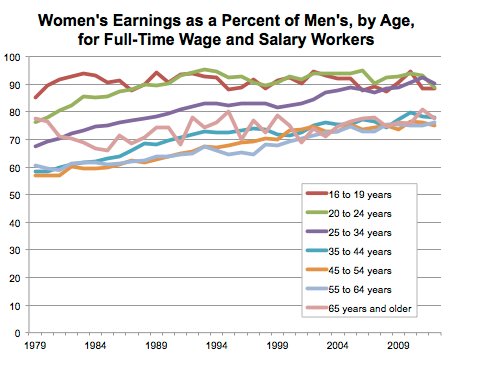Everybody pretty much agrees that women make less money on average than men. Whether that means that women should march into their office and demand a raise is a completely different and much more complicated question. Below are 10 things you should know about the difference in men and women’s earnings, with charts! 
1. Women who work part time actually earn more than men who work part time.
2. The wage gap is smaller the more educated and less married women are. But then there’s motherhood. Ouch.
In this chart, where the shorter lines mean less inequity, sociologist Philip Cohen uses 2011 American Community Survey statistics to show that for Full Time Year Round (FTYR) workers, not having kids can shrink the wage gap by 6 or 11 percentage points. Marital status has more influence on the wage differential between men than education does: an unmarried High School educatd woman has a smaller wage gap than a PhD with kids. Being unmarried AND not having kids makes the race much closer. But beware, that doesn’t mean these figures are just about time spent at work, which brings us to…
3. Women who work more than 50 hours a week often suffer a bigger gender gap than those who don’t. (See those long dark green lines above.)
From the Bureau of Labor Statistics annual report.
This drop may have been recession-related, as industry hiring picked up and more better paying jobs became available for men again.
5. The wage gap is narrower for younger workers.
This may have something to do with changing ideas about women’s pay and legislative efforts such as the Lily Ledbetter Act, but is more probably because women now graduate from college in greater numbers than men and those women tend—at first—to be childless and unmarried. You’ll notice there’s a big difference after a woman turns 35, when she’s more likely to have children.
6. The smallest gender gap for college graduates is among people who studied architecture.
That’s a weirdly big gap, and the only plausible explanation I have is that architecture is a very male dominated industry, so the women who break through can charge a premium for their services.
7. The gender wage gap is smallest among African Americans and biggest among Asians.
In 2012 Asian women earned 73% as much as their male counterparts, while Black women earned 90% as much as theirs. However Asian women’s median salary was $770, while Black women’s was $599. So there’s that.
8. Only 25% of women work in occupations where women’s median earnings are less 77% of men’s median earnings.
from Family Inequality
9. Then again, only 25% of women work in occupations where women’s median earnings are more than 90% of men’s median earnings.
10. The country with the most gender equality in the world, not just in terms of wage parity but in terms of political empowerment and participation, health and survival and educational attainment is, drumroll please, Iceland, for the fifth year in a row. The U.S. is 23rd, right behind Burundi.
Check where other countries fall on this interactive map.









